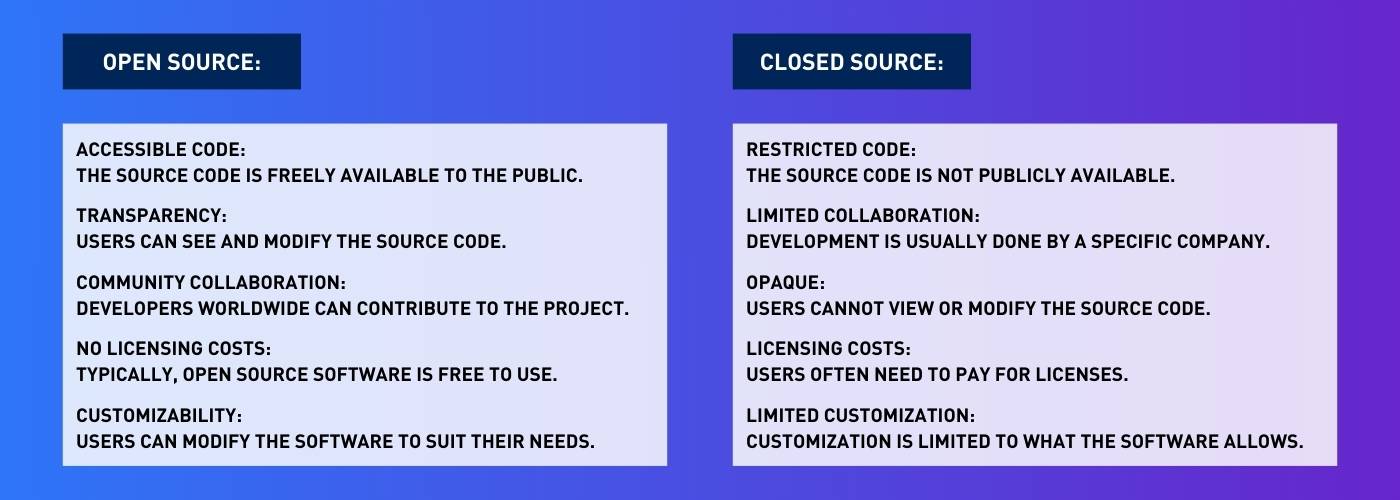Imagine a world where the blueprints for every invention, from smartphones to medical devices, were freely available for anyone to explore, modify, and improve upon. This is the power of open source technology. In contrast, closed source software hides its inner workings like a well-guarded secret. So what exactly are open source and closed source? And why should you care? We’ll dive into the fascinating world of software development and explore how these two approaches shape the technology we use every day.
What’s the Difference Between Open Source and Closed Source?
Open source and closed source are two different software development models with distinct characteristics. Open source refers to the approach where the source code of a software is freely available, allowing users to view, modify, and distribute it as they see fit. This collaborative nature fosters innovation through shared knowledge and feedback from a wide community of developers. Open software like Acronis backup, VLC media, GNU/Linux, Android and more have thriving open-source community and forum members.
On the other hand, closed-source software keeps its underlying code hidden from users. This model relies on proprietary licenses that restrict users’ access to the source code. While this can protect intellectual property rights and provide control over distribution, it also limits opportunities for collaboration and customization.
One fresh perspective to consider is that open-source projects have gained immense popularity in recent years due to their inclusive and transparent nature. The collective effort of numerous developers ensures that bugs are discovered more quickly, resulting in timely updates and improvements.
Additionally, open-source products often benefit from community-driven support forums where users can share tips, tricks, and troubleshooting advice.
Another alternative viewpoint is how closed-source software can sometimes be associated with high security standards due to the reduced accessibility of their source code. Organizations might choose this approach when handling sensitive data or protecting trade secrets.
However, critics argue that relying solely on closed-source solutions may increase dependency on a single vendor while limiting user empowerment.
Understanding the differences between open source and closed-source models provides valuable insights into how software ecosystems function differently under these approaches. While open source encourages collaboration and customization through sharing knowledge openly within communities for mutual benefit; closed-source models prioritize control
Pros & Cons of Open Source
One of the most significant advantages of open source is cost-effectiveness. Since open-source software is freely available to download and use, businesses can save a considerable amount on licenses and subscriptions.
This accessibility also enables rapid innovation as developers worldwide contribute to improving the codebase and adding new features regularly.
Another compelling aspect of open source is its flexibility. Companies have the freedom to customize open-source software according to their specific needs. Unlike proprietary software that limits customization options, open source allows organizations to modify the code and tailor it precisely for their requirements.
This level of customization grants businesses an unparalleled level of control over their technology stack, empowering them to create unique solutions without relying heavily on third-party vendors or waiting for updates from closed-source companies. This is why so many artificial intelligence open-source software have been thriving.
Moreover, open source fosters collaboration among developers and encourages knowledge sharing within communities worldwide. This collective effort accelerates problem-solving processes, facilitates peer review, enhances security measures, and ensures constant improvement through feedback loops.
While open source software has its fair share of benefits, it also comes with some notable drawbacks. One major concern is the level of support available. With open source projects, there may not be a dedicated customer support team readily available to address user issues and provide timely assistance.
This can leave users feeling frustrated and unsupported, particularly if they encounter technical difficulties or require troubleshooting guidance.
Furthermore, open source software may lack the same level of polish and refinement as commercial alternatives. The development process for these projects tends to involve contributions from various developers around the world, each with their own coding styles and priorities.
As a result, the user interface and overall user experience can be inconsistent or less intuitive compared to proprietary solutions that have been fine-tuned by dedicated teams working towards specific design goals.
Pros & Cons of Closed Source
One of the main advantages of closed-source software is its ability to provide a higher level of security. Since the source code is not readily available to the public, it becomes more difficult for malicious users to exploit vulnerabilities and create unauthorized modifications.
This can be particularly beneficial for applications handling sensitive information such as financial or medical data.
Another advantage of closed-source software is the level of control that developers have over their product, which can be done through a dedicated cloud environment. With an open-source model, anyone can modify and distribute the software, potentially leading to fragmented versions and lack of consistency.
In a closed-source environment, developers have complete control over all aspects of their software, including updates and features. This level of control allows for smoother integration with other systems and better overall user experience.
While closed source has its benefits, there are also several downsides to this approach. One major drawback is the lack of transparency. Closed source software often comes with restrictive licensing agreements that can hinder user freedom.
Users are typically required to adhere strictly to the terms and conditions set forth by the vendor, limiting their ability to modify or customize the software according to their specific needs. This lack of flexibility can be frustrating for individuals or organizations looking for tailored solutions.
Another disadvantage of closed source is the reliance on a single vendor for support and updates. If a company discontinues support for a particular product or goes out of business, users may be left without updates or patches necessary for keeping their software secure and relevant. This vulnerability can lead to compatibility issues with other systems as technology advances.
How To Choose Between Open & Closed Source
When it comes to choosing between open source and closed source software, there are several factors that need to be considered. One of the main advantages of open source software is that it is typically free to use and modify, offering a cost-effective solution for those on a tight budget. Closed source software, on the other hand, often requires a license fee or subscription, but offers the benefit of professional support and the assurance of regular updates and security patches.
However, one must also consider that with open-source software comes the responsibility of maintaining and troubleshooting any issues that arise. While there are vast communities of developers who contribute to open source projects and offer support through forums and documentation. Ultimately, you may have to rely on your own problem-solving abilities or hire additional resources if necessary.
Conversely, closed-source software companies often provide dedicated customer support teams who can assist with any technical difficulties promptly. The decision rests upon evaluating your budget constraints, technical expertise within your team, level of customization required for your project, as well as considering how much control you want over the development process.
In conclusion, the choice between open source and closed source ultimately depends on individual preferences and project requirements. While open-source software can offer cost savings in terms of licensing fees while also encouraging collaboration among developers worldwide; closed-source options tend to prioritize ease-of-use and provide reliable customer support services.
Weighing these pros and cons will help determine what best suits your needs – whether you value affordability or convenience – as both options can deliver quality solutions when approached thought






阅读更多
Sharktech Announces New Web Hosting and Cloud Industry Alliance
Sharktech and 2
3 月
Think the Cheapest Dedicated Server is A Good Idea? What You Need to Know
Shoul
3 月
Discover How These 8 Cloud Monitoring Tools Can Help You Drive Better Business Performance
When
3 月
Pick the Best Cloud Management Platform with These 5 Pro Tips
Managi
3 月
Thinking About Public to Private Cloud Migration? Here’s the Essentials
The clou
3 月
Why a Cloud Migration Checklist Helps Overcome Migration Challenges
Moving d
3 月